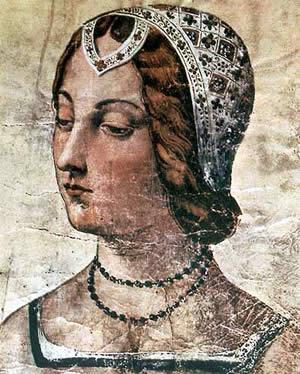

The story of Laura and Petrarch is a page in our history that has often been sung, played and written. We are not going to further develop it. The beautiful, fragile and chaste LAURA lived, and died, her death inspiring in the heart of the poet PETRARCH the "canzones", a permament wound from which flowed like indelible ink the endless source of his talent.
Often writers have maintained that LAURA existed only in the prolific imagination of the great poet Francesco PETRARCA known as PETRARCH.
Much ink has been spilled on this subject.
But the existence of LAURA is not a question of a simple theory. The study of varied documents found in such different places as Milan, Lyon and Avignon permit us to reaffirm that she was a real person.
Laure de NovesThen we might ask, who was the real LAURA, for there are, once again, many diverging points of view. From the rare, nonetheless veritable indications left to us by Petrarch, and above all by a study of geneaological tables, notarial acts and official registers, we discover that the LAURA born in 1310, in Avignon, daughter of the Knight AUDIBERT de NOVES, wife of HUGUES II de SADE (son of Paul), as confirmed by the marriage contract drawn up by Raymond FOGASSE on January 16, 1325, unite all the characteristics that justify her identification.
From some notes jotted down in PETRARCH'S own hand - a writing "even more obscure than heiroglyphics" - in his copy of VIRGIL, know found in Milan, we discover:
"LAURA, illustrated by her virtues and well-celebrated in my verse, appeared to me for the first time during my youth in 1327, on April 6, in the Church of Saint Claire in Avignon, in the first hour of the day; and in the same city, in the same month, on the same sixth day at the same first hour in the year of 1348, the light itself lost its sparkling beauty, at which time I was in Verona, unaware, alas, of my misfortune. The so beautiful and so chaste body of LAURA was buried in the convent of the "freres mineurs" the same day in the evening".
PetrarqueThe cause of her death has not been irrefutably established. Many historians believe it was the plague, as that same year Avignon suffered its worst epidemic. However, none of the people actually present at her death mention any of the agonizing symptoms of the "Black Death". We can also suppose that she died of cinsumption, following a pulmonary tuberculosis resulting from eleven childbirths. She was only 38 years old.
As the wife of HUGUES, it is only logical to suppose that she was buried in the chapel of the SADE, the "Chapelle des Cordeliers" rue des Teinturiers. The Lyonnais humanist and poet Maurice SCEVE believed so in 1532 when he saw the sepulchral stone bearing the family arms of "2 intertwining laurel branches over a cross and heraldic rose." He had the tomb opened and discovered, in a lead box, a medal representing a woman ripping at her bosom, as well as a "Sonetto" attributed to PETRARCH.
A few months later, in August 1533, Francois I, who oft-visited Avignon and presently on his 7th (!) visit, observed as the tomb was once again opened in the Chapel where he had come to meditate. He composed especially for this occasion the famous verses which remainwith her in her tomb
En petit lieu comprins vous pouvez veoir
Ce qui comprend beaucoup par renommée.
Plume, labeur, la langue et le sçavoir
Furent vaincus par l'aymant de l'aymée
O gentille âme ! estant tant estimée,
Qui te pourra louer qu'en se taisant,
Car la parole est toujours réprimée,
Quand le sujet surmonte le disant.
Excerpts from a Text by Marc Maynegre